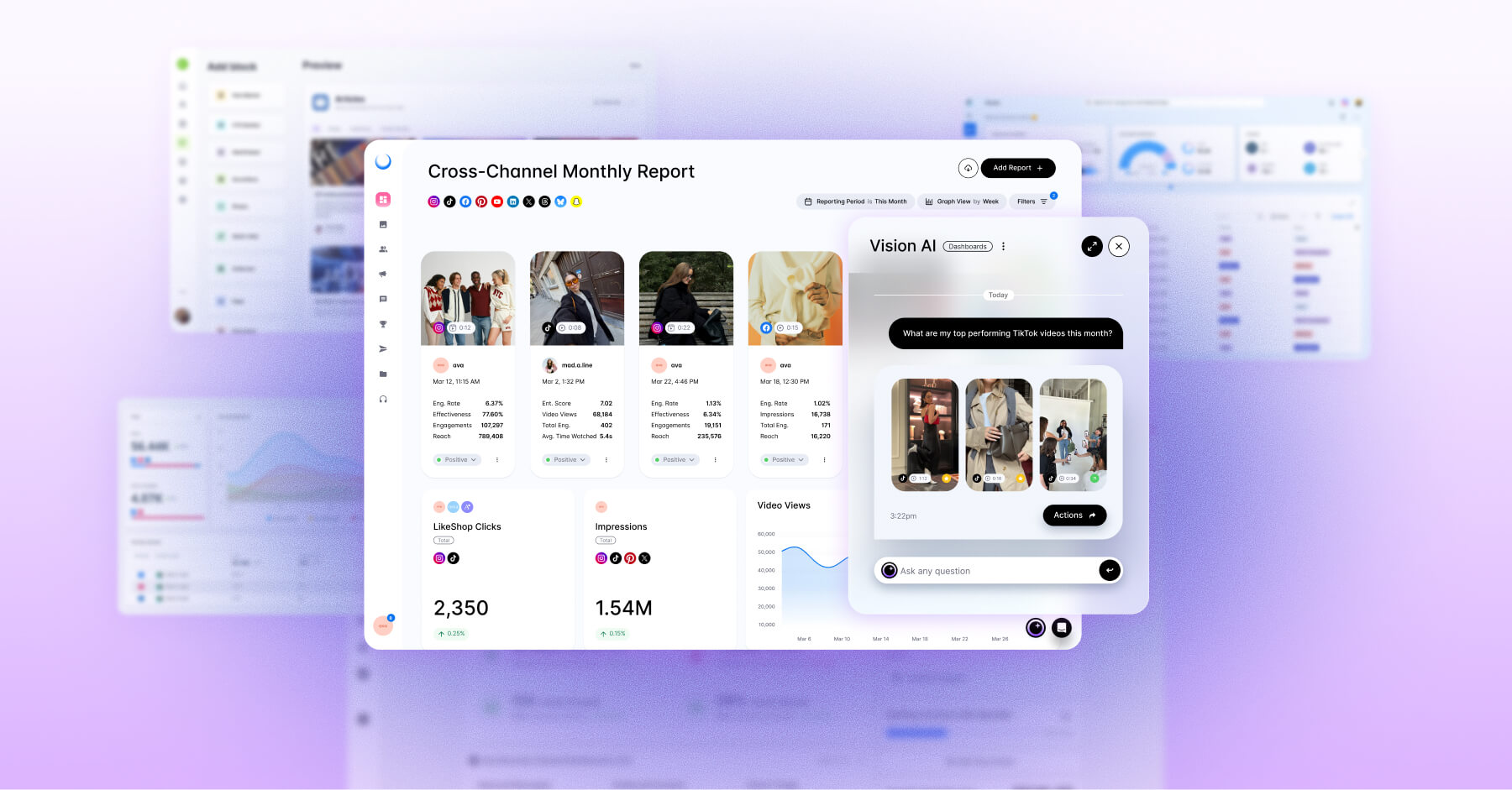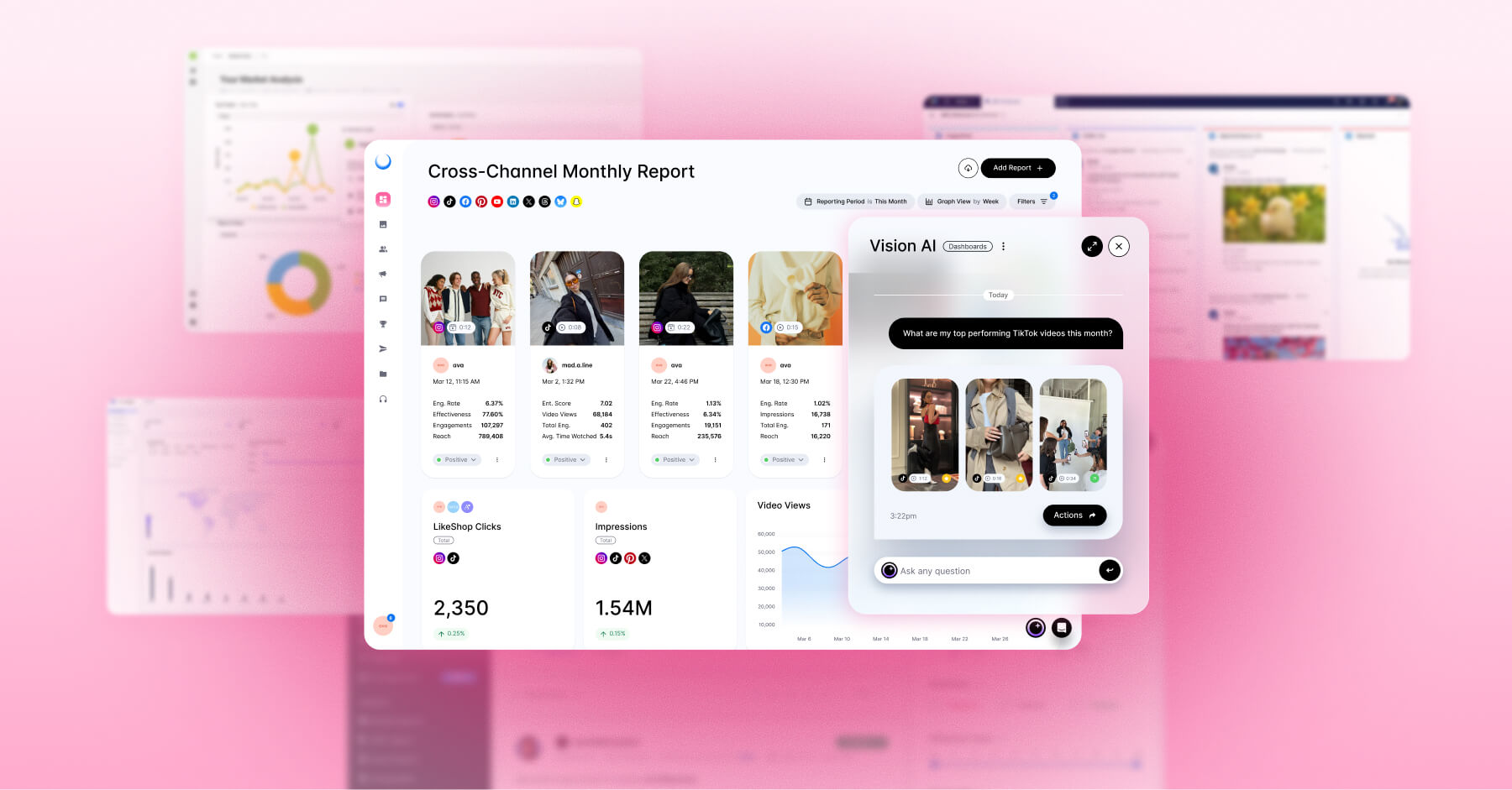What Is Competitive Benchmarking? A 101 Guide for Marketers and Brands
Outperform your rivals by turning competitor data into smarter social moves with competitive benchmarking.
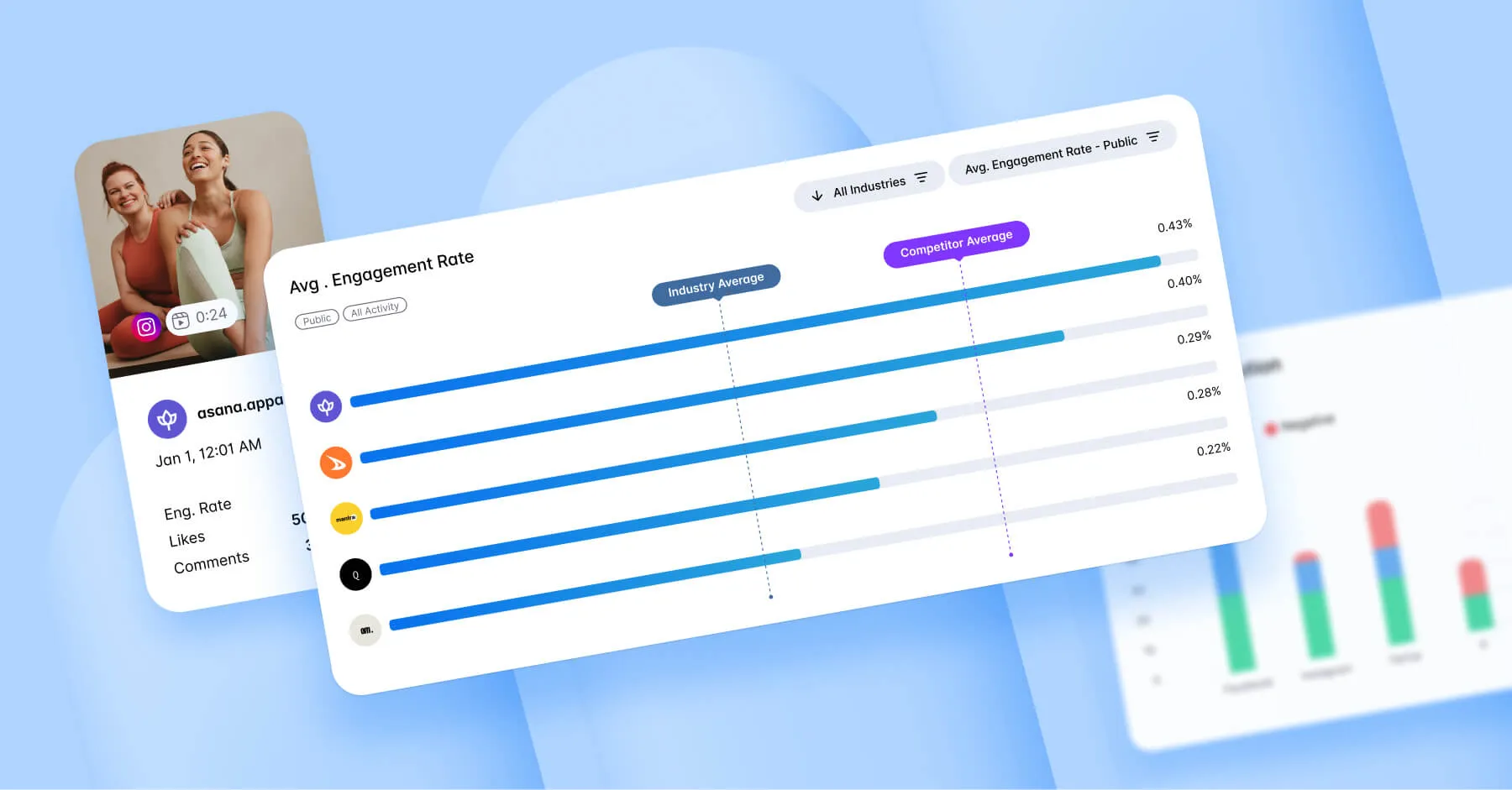
Competitive benchmarking is the difference between making your mark and surpassing it. While setting your own goals and objectives is always best, benchmarking against relevant competitors gives you the missing context on how others in your space perform, what works for them and where your brand stands in comparison. It’s not about replicating their content to achieve the same results, but about learning from their wins and misses to improve your own strategy.
When attention is limited and competition is constant, competitive benchmarking and understanding how your brand measures up provide the clarity you need to make the smartest social media moves.
TL;DR:
- Competitive benchmarking compares your brand’s performance metrics to competitors to give context and guide realistic goal setting
- It identifies strengths, gaps and opportunities by tracking audience, engagement, content, paid media, sentiment and share of voice metrics
- Benchmarking differs from competitive analysis by focusing on raw performance data rather than interpreting it for strategy
- The process involves setting goals, choosing relevant competitors, defining metrics, gathering data, spotting trends and setting benchmark goals
- Regularly revisiting benchmarks helps refine strategy, track progress and stay ahead of industry shifts
What Is Competitive Benchmarking?
Competitive benchmarking is the process of evaluating your brand’s performance by comparing key metrics to your competitors. For social media specifically, this means looking at benchmark data like average engagement rates across a given industry, individual competitor performance trends and even posting frequency benchmarks like the average number of posts published per week. It gives context to your results, helping you understand whether you’re underperforming, meeting or even outperforming the standard set by competitors in your space.
Why Is Competitive Benchmarking Important?
Competitive benchmarking is important because it helps you set realistic performance standards based on what’s happening in your industry, not just within your own brand. Instead of guessing what ‘good’ means for your goals, you’re working with concrete data pulled from competitors who typically target the same audience. Having this scope helps you identify gaps, highlight strengths and find opportunities to improve your overall social media strategy with decisions rooted in context, not assumptions.
Competitive Benchmarking vs. Competitive Analysis
Although competitive benchmarking and competitive analysis go hand-in-hand, the two processes are quite distinct. Competitive benchmarking focuses on identifying and gathering performance metrics and content tactics used by your competitors or others within your industry.
For example, does your top competitor rarely share Reels content? What’s the average follower growth rate from competitors with a similar amount of followers? Understanding these numbers gives you a realistic idea of where your performance should be. Are you fielding questions about why your engagement rate isn’t skyrocketing? Competitive benchmarking shows if you’re on par or even doing better than brands, which is essential to setting SMART goals and avoiding unrealistic expectations.
On the other hand, competitive analysis builds on benchmarking data by interpreting it along with content ideas, post types and any other relevant factors from competitors and your own performance. Competitive analysis identifies the patterns and gaps to generate actionable, data-backed recommendations.
Top Metrics To Track in Competitive Benchmarking
While there are a myriad of social media KPIs a brand could look at, they can be boiled down to a few key metrics that brands can use during the social media analysis process.
Audience Metrics
Audience metrics reveal how well competitors are expanding their reach, along with who their audience is. Typically, you’ll have a similar audience demographic to your competition; however, you might be targeting different segments. Gathering audience metrics helps you understand which audience segments you reach organically, where there’s opportunity to get more followers, who your competitors’ followers are and which platforms they’re active on to grow their social presence.
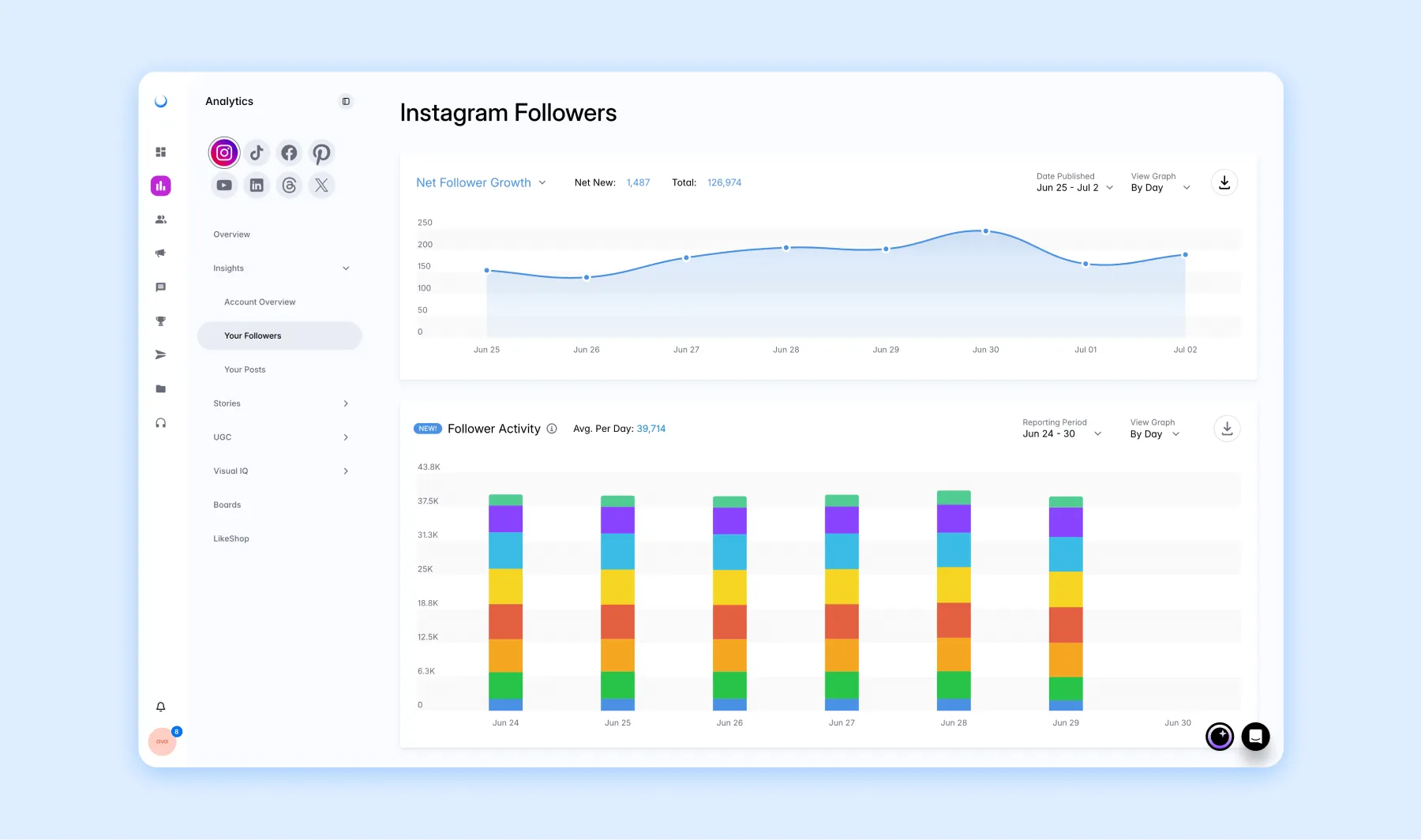
Different audience metrics include:
- Follower count: How many followers do they have?
- Follower growth rate: How fast are they gaining or losing followers?
- Audience demographics: Where does your audience live? Are they Millennial or Gen Z? What are their interests?
- Platform presence: Which social channels are followers active on? Are you prioritizing the right social channels based on audience preferences?
Engagement Metrics
Engagement metrics measure how audiences interact with your competitors' content. Look at engagement rate per post, average comments, share rate, video views and watch time to understand how compelling their content is. High engagement levels signal content that captures audience interest, while low interaction may point to missed opportunities in creative or messaging strategy.

Common engagement metrics to track for benchmarking include:
- Engagement rate per post: Measures how much interaction (likes, comments and shares) a single post receives relative to the account’s follower count.
- Average engagement: What’s your average engagement rate across all posts? What’s your average industry engagement rate?
- Shares: How often content is shared.
- Video views: How many times your video content, including short-form video like Reels and YouTube Shorts, are viewed.
- Watch time: How much of your video are users watching?
Content Strategy Metrics
Content strategy metrics give insight into what to post, how often to post and why certain posts perform well. Evaluate frequency, content mix (photos, videos, carousels, etc.), top-performing content and hashtag strategy to find patterns in competitor success. Identifying what formats and topics are driving results in your niche will help inform your own content planning.
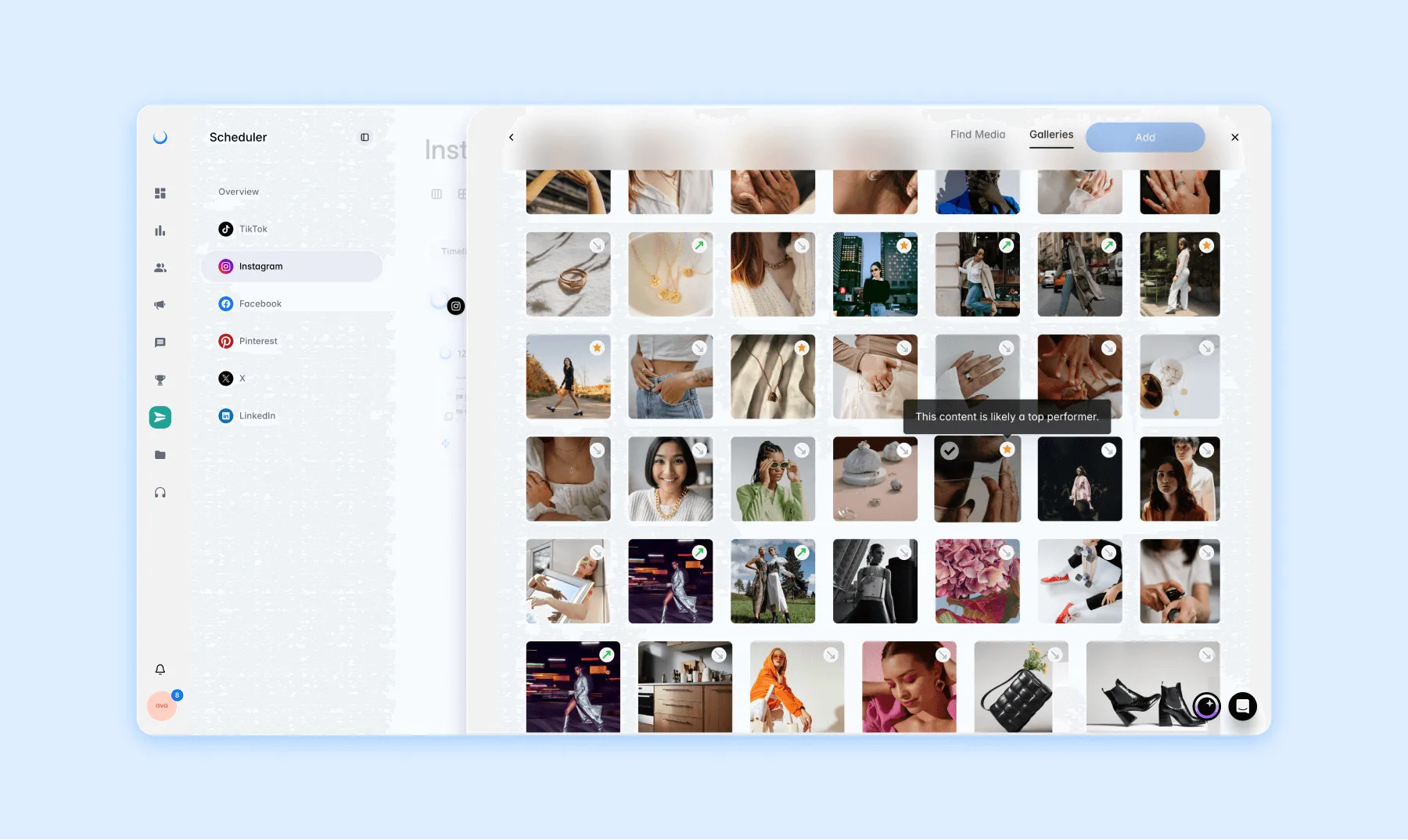
Some of the most popular metrics to benchmark in terms of content strategy include:
- Post frequency: How often do they post?
- Content mix: What types of content are they sharing — Instagram Reels, Shorts, Stories, carousel posts, long form videos and more. Beyond the actual type, what sort of content themes do they publish?
- Top performing posts: What are the top-performing posts?
- Hashtag strategy: How are hashtags used across platforms and posts? Are they featured in the bio? What types of branded hashtags are used?
Paid Social Metrics
Paid social benchmarking highlights how competitors are using social media advertising, how much they’re investing in paid media and what their campaigns look like. When possible, compare sponsored engagement (likes, shares and comments) to organic performance using tools like Meta Ad Library to understand what paid content moves the needle.
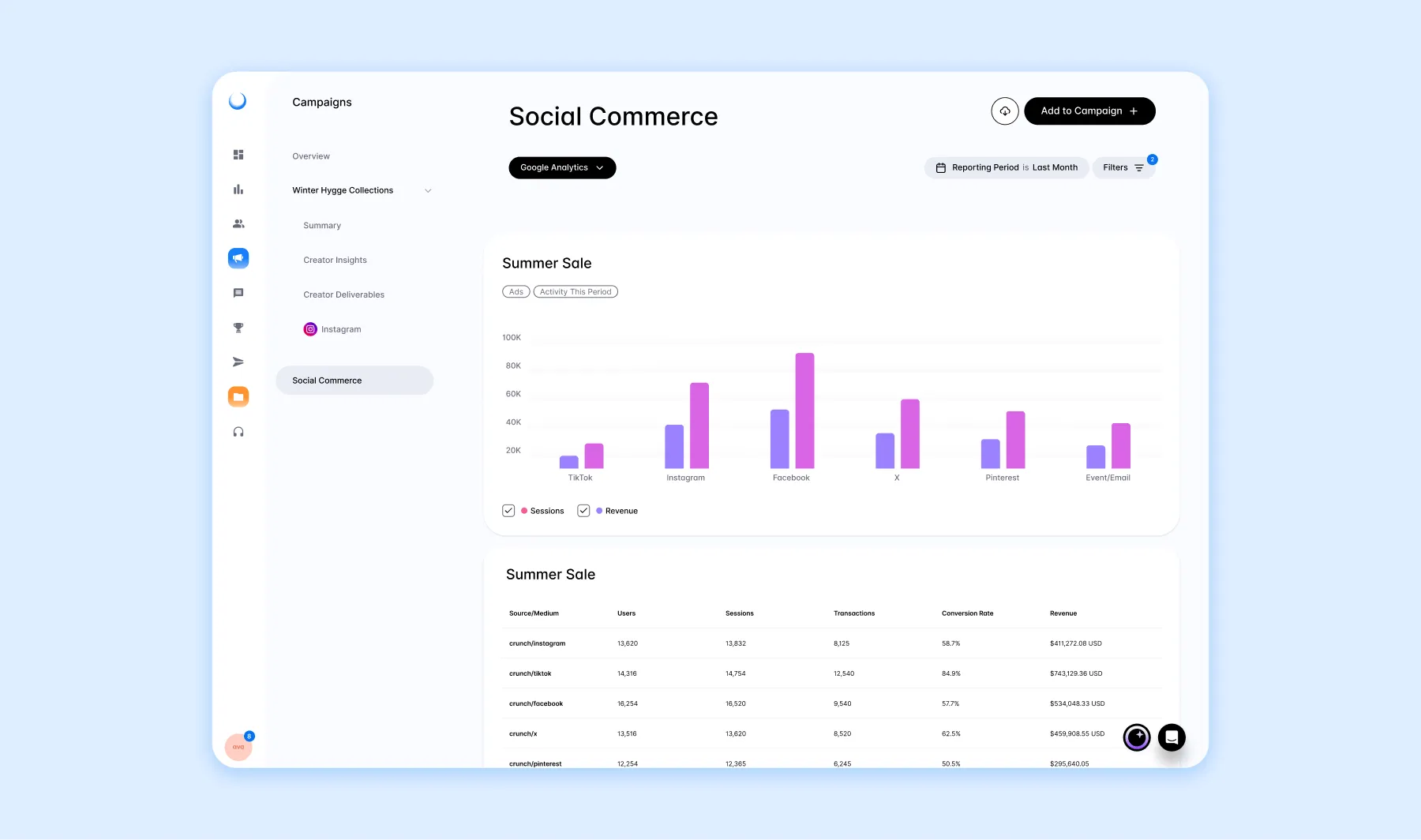
Typical paid metrics to benchmark your performance against include:
- Active campaign volume: Number of paid social campaigns currently running.
- Creative format: Type of ad content used, such as video, carousel, or static image.
- Website traffic/clicks: Amount of visitors who land on your website through paid content.
- Sponsored engagement: Interactions (likes, comments, shares) on paid posts.
Sentiment and Brand Perception Metrics
The ability to measure sentiment is one of the biggest advantages modern marketers have. While most metrics offer a quantitative measurement of performance, sentiment and brand perception metrics give you the qualitative piece of the puzzle. You might receive thousands of comments, but if they’re negative, this isn’t necessarily the engagement you’re aiming for. What’s more, measuring competitor sentiment is proactive, which can help you avoid making similar mistakes in your own approach to content.
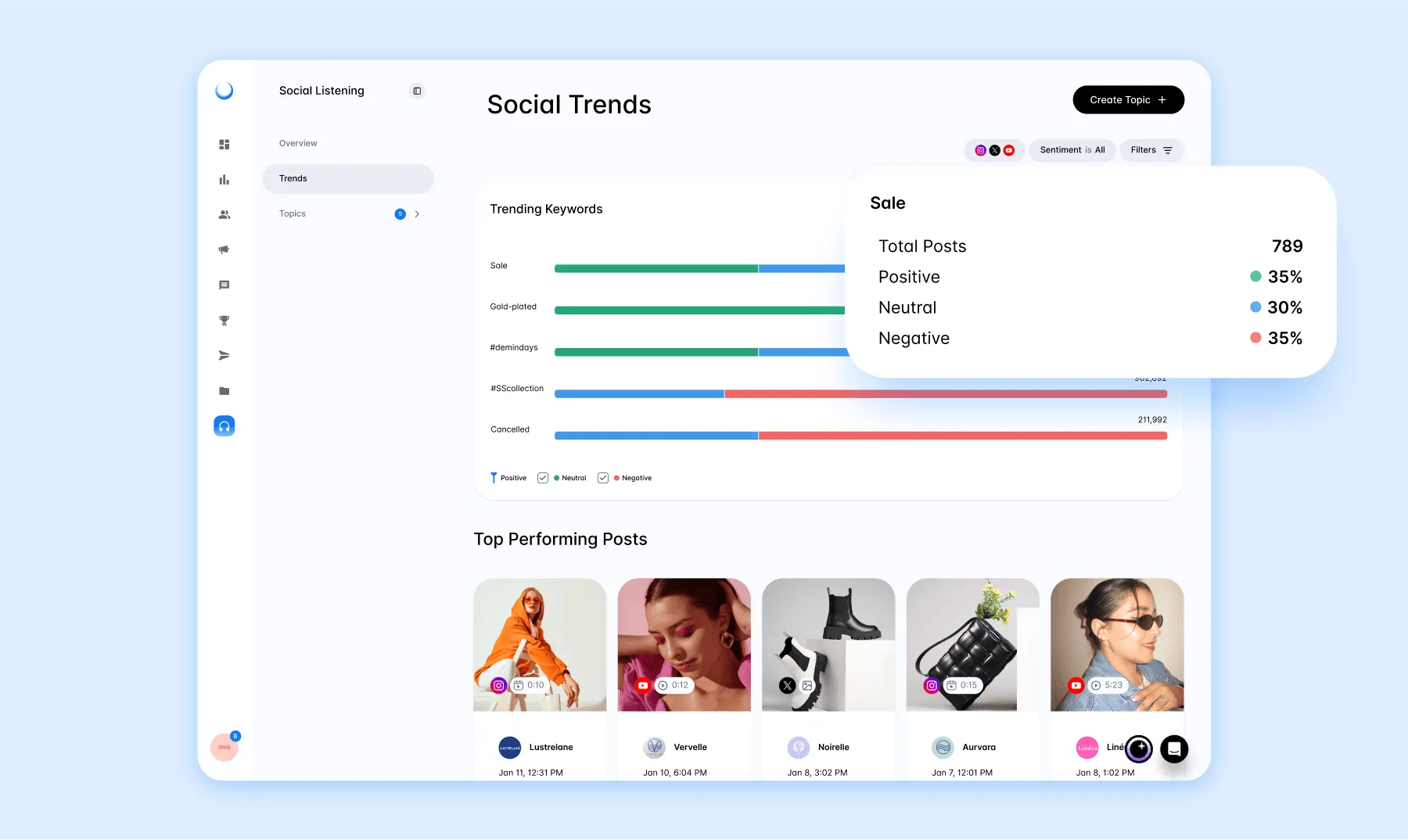
To benchmark sentiment and brand perception, you should be looking at:
- Sentiment analysis: Measures the ratio of positive, neutral and negative mentions about a brand.
- Brand mentions: Instances where a brand is named in posts, comments, or captions.
- Tags: Direct tags of a brand’s handle in social content or comments.
- Influencer partnerships: Collaborations where influencers create content featuring or promoting a brand.
Share of Voice
Share of voice (SOV) measures how much space a brand occupies in the social conversation relative to others. Track SOV by brand or specific topics to see how often your competitors are being talked about, and pinpoint which trending discussions they’re actively engaging in. A strong share of voice signals authority, relevance and provides context for your own visibility and messaging. These are the metrics you'll want to benchmark to effectively measure share of voice:
- Share of voice: Measures how often a brand is mentioned in conversations compared to competitors.
- Trending topics: Popular themes or hashtags competitors are engaging with to stay relevant.
7 Steps to Perform Competitive Benchmarking
Competitive benchmarking is the edge every content marketing strategy needs. While setting your own goals is important, comparing them against industry averages and competitor performance provides the context to ensure your goals are realistic and impactful.
Step 1: Identify Your Business Goals
Before you dive into data, take a beat to define what you're really aiming to improve. Want more eyeballs on your brand? Looking to boost engagement? Or maybe you're trying to figure out which product features make people click ‘buy.’ Think of goals like a compass for your benchmarking journey: they’ll help you determine what to track and compare yourself against.
Step 2: Select the Right Competitors
Next, it’s time to pick the brands to benchmark against. Choose three to five competitors that make sense. These could be direct rivals, brands you admire or up-and-coming disruptors shaking things up in your niche. Social listening tools make this step a breeze. Make sure you're comparing brands with similar goals, audiences or positions in-market to keep your insights meaningful.
Step 3: Define Key Metrics and Benchmarks
With your goals and competitors in place, decide what numbers matter. Are you tracking social engagement? Website traffic? Product pricing? Choose metrics that tie directly to your business goals. There’s no need to collect data just for data’s sake. You want insights that will actually move the needle, not create meaningless busywork for your team.
Step 4: Gather Data
Now, it’s time to roll up your sleeves and gather the data. Start with social media analytics tools like Dash Social to quickly pull performance insights across key channels. Then, layer in manual research from your competition’s social profiles and even websites or other sources, like industry articles, to fill in any gaps and provide as much ‘intel’ for your team as possible. Combining automated tools with hands-on digging gives you a more complete, accurate picture.
Step 5: Analyze the Gaps and Trends
Put your brand’s performance alongside your competitors and see what stands out. Are they winning with Reels? Is their posting cadence tighter? Finding content gaps is perhaps the most impactful step for creating action items, since it’s all about finding areas where competitors have an edge and finding patterns you can learn from.
Step 6: Set Benchmark Goals
Once you have a clear view of where you stand, it’s time to turn insights into action. Set realistic, measurable goals based on your findings. Maybe you aim to bump your engagement rate by 15% to keep up with a top player. The clearer your targets, the easier it’ll be to measure success when you meet or exceed your targets.
Step 7: Adjust Your Strategy and Monitor Progress
Now that you’re armed with data and goals, it’s social media reporting time. Here, you can examine your progress and tweak your strategy accordingly. Make it a habit to revisit benchmarks at least every quarter so you can track wins, adjust where needed and stay ahead of industry shifts.
Because in social, what’s hot today might be old news tomorrow — remember when commenting 50 hashtags was the go-to move? Social evolves, and competitive benchmarking helps you evolve with it.
Competitive Benchmarking FAQs
What is an example of competitive benchmarking?
Let’s say your team notices that a competitor’s Instagram Reels consistently outperform yours in views and engagement. Through competitive benchmarking, you track their post frequency, content style, hashtags and engagement rate over time. You discover they post Reels three times a week with behind-the-scenes content and a trending Instagram Reels song. Using this data, you adjust your content strategy to test similar formats in your own unique brand voice and style, aiming to close the gap or outperform them in engagement.
Why do you need to monitor your competitors?
You should monitor competitors because it helps you keep tabs on them and stay sharp and proactive. It reveals what’s working for others, where your brand might be falling behind and lets you find new opportunities. Monitoring competitors is not about copying, it’s about learning, adapting and being proactive.




